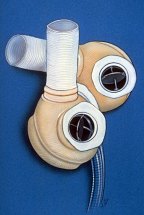The Jarvik 7 is described here for historical purposes. The device in its original form is no longer in use.
The Jarvik 7 total artificial heart is probably the best known of the artificial heart devices. Named for its designer, Dr. Robert Jarvik, the Jarvik 7 was designed to function like the natural heart.
Clinical evaluations of a total artificial heart for permanent use in patients began in 1982, when surgeons at the University of Utah implanted the device in a patient named Barney Clark. He survived with the Jarvik 7 for 112 days. Five more implantations of the Jarvik 7 were performed through 1985. The longest survivor was William Schroeder, who was supported by the Jarvik 7 for 620 days. By the late 1980s, surgeons at 16 centers, including THI, had used the Jarvik 7 as a bridge to heart transplantation in more than 70 patients.
Later, the Jarvik 7 was renamed the Symbion total artificial heart. After some minor changes to its design, it was again renamed the CardioWest total artificial heart. Today, the device is called the SynCardia temporary Total Artificial Heart.
 The Pump
The Pump
The Jarvik 7 had two pumps, much like the heart's ventricles. Each sphere-shaped polyurethane "ventricle" had a disk-shaped mechanism that pushed the blood from the inlet valve to the outlet valve. The ventricles were pneumatically (air) powered. Air was pulsed through the ventricular air chambers at rates of 40 to 120 beats per minute. The artificial heart was attached to the heart's natural atria by cuffs made of Dacron felt. The drivelines out of the ventricular air chambers were made of reinforced polyurethane tubing. The lines were covered where they exit the skin with velour-covered Silastic to ensure stability and encourage tissue growth even with movement by the patient.
The Console
The air-driven, external power system powered the pump through drivelines that entered the heart through the patient's left side. The large console on wheels was as large and as heavy (but not quite as tall) as a standard household refrigerator, and was normally connected to sources of compressed air, vacuum, and electricity. The system was backed up by a rechargeable battery in case of power failure and included on-board compressed air tanks (modified scuba type) for use during patient transport. Controls in the console allowed doctors to control pump rate, pumping pressure, and other essential functions.
For more information, you can read an article entitled, "Cardiac Replacement with a Total Artificial Heart as a Bridge to Transplantation," which appears in Volume 351 (2004) of the New England Journal of Medicine (pp. 859-867).
Updated November 2011



